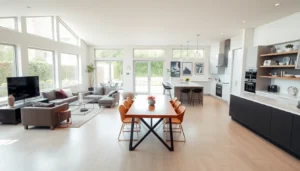The rental market is more dynamic than a cat chasing a laser pointer. With shifting demographics and economic factors, it’s crucial to stay ahead of the curve. Whether you’re a landlord trying to fill vacancies or a tenant hunting for the perfect pad, understanding these trends can save you time and money.
Table of Contents
ToggleOverview of Rental Market Trends
Rental market trends indicate significant fluctuation influenced by several economic factors. Rising inflation affects rental prices, causing increases in monthly rates across many metropolitan areas. In addition, shifts in demographics play a crucial role, as younger generations seek rental options in urban locations, highlighting a desire for convenience and accessibility.
The demand for single-family rentals continues to grow, especially among families looking for more space during and after the pandemic. Market data shows that remote work has solidified the preference for larger living spaces, driving demand in suburban markets.
Rental vacancy rates also reflect changing preferences. The National Multifamily Housing Council reported an average vacancy rate of 5.8% in Q3 2023, with variations depending on location and property type. Urban areas generally experience lower vacancy rates as they attract a steady stream of new residents.
Rental applications are being submitted more quickly, often within days of listing. This rapid competition can lead to increased rental prices, particularly in high-demand neighborhoods. Landlords expressing flexibility in terms of lease agreements find success in attracting tenants.
Moreover, technology integration in property management streamlines the rental process. New platforms enable landlords to efficiently list properties and manage tenant inquiries. These advancements simplify the rental experience for both parties, ensuring timely communication and ease of access.
Understanding these trends allows stakeholders to navigate the rental market effectively. Planners, investors, and tenants benefit from staying informed about these dynamic fluctuations, ultimately leading to better decision-making for all involved.
Current Rental Market Conditions

Understanding current conditions in the rental market is essential for both landlords and tenants. Recent trends indicate significant variations in urban and suburban rental dynamics, as well as fluctuations in rental prices.
Urban vs. Suburban Trends
Urban rental markets are witnessing lower vacancy rates due to new residents moving in. Cities offer convenience and accessibility, attracting younger generations who favor close proximity to employment and amenities. In contrast, suburban areas are experiencing a surge in demand for single-family rentals. Families desire more space, driven by lifestyle changes during the pandemic. Remote work continues to influence this trend, leading many to prioritize larger living spaces over urban convenience.
Rental Price Fluctuations
Rental prices have seen notable increases, especially in metropolitan areas. Inflation plays a significant role, pushing prices higher across various property types. In Q3 2023, landlords reported an average rental vacancy rate of 5.8%. High-demand neighborhoods show even more intensity, leading to competition among renters. Many applications arrive swiftly, often within days of listings. This rapid submission rate contributes to rising prices, particularly where flexible lease options attract tenants.
Factors Influencing Rental Market Trends
Rental market trends are shaped by multiple interconnected factors. Economic conditions and demographic shifts play crucial roles, prompting changes in demand and rental pricing.
Economic Influences
Economic stability directly impacts rental markets. Rising inflation has led to increased rental prices across many metropolitan areas. Employment rates significantly affect how much residents can afford in rent. Areas experiencing job growth often see higher demand for rentals, driving competition. Increased material and construction costs also contribute to rising prices, as landlords pass expenses onto tenants. Data from Q3 2023 highlights an average rental vacancy rate of 5.8%, illustrating heightened competition for available units. Investors and landlords must adapt to these economic indicators to attract and retain tenants.
Demographic Shifts
Demographics influence rental preferences and demands. Younger generations prioritize convenience and accessibility, gravitating towards urban locations. Families, on the other hand, are leaning towards single-family rentals that offer more space. The pandemic has intensified this trend, with remote work becoming a permanent fixture for many. As such, suburban areas witness a surge in demand for larger living spaces. Understanding these demographic shifts allows landlords and investors to tailor their offerings to meet tenant needs. Keeping an eye on these changes helps navigate rapidly evolving rental landscapes effectively.
Regional Rental Market Trends
Regional rental markets reflect diverse patterns influenced by various factors. Awareness of these dynamics proves essential for landlords and tenants.
Major Cities Analysis
Major cities continue to show strong demand for rental properties. Urban centers report an ongoing influx of residents, contributing to lower vacancy rates. For instance, rental prices in cities like New York and San Francisco surge due to high demand in prime locations. The increasing preference for convenience drives young renters to urban apartments. Competition remains fierce, with many applications submitted within days of a listing. Furthermore, flexible lease options attract renters seeking short-term commitments.
Emerging Markets
Emerging markets reveal a shift toward suburban living. Families increasingly seek larger homes with outdoor spaces, reflecting post-pandemic preferences. Areas like Austin and Nashville see new developments catering to this growing demographic. Rising job opportunities and economic growth in these cities fuel demand for rentals. Statistics show that single-family rentals in these regions account for a significant portion of market activity. Landlords who adapt to these trends by offering spacious properties often succeed in attracting tenants. Technology’s role also enhances the experience for both tenants and property managers in these evolving markets.
Future Outlook on Rental Market Trends
Future trends in the rental market suggest that urban areas will continue to attract younger tenants due to their convenience. As inflation persists, rental prices are expected to rise further in metropolitan regions where demand outstrips supply. Increased interest in suburban living remains strong, particularly among families seeking more space; a trend confirmed by rising numbers of single-family rentals.
Vacancy rates, currently averaging 5.8%, are projected to tighten as new residents flock to cities. Urban centers like New York and San Francisco will likely experience continued price surges despite their already high rental rates. Many landlords are adapting by offering flexible leases, ensuring they remain competitive amid growing demand.
Technological advancements are set to transform property management. Automation will simplify listing processes and communication, fostering better experiences for both landlords and tenants. Enhanced technologies will also expedite rental applications, enabling quicker decision-making on both sides.
Economic stability plays a crucial role in shaping future rental behaviors. An increase in job opportunities can spur demand in both urban and suburban markets. With cities like Austin and Nashville emerging as hotspots for families, the ongoing trend toward sizeable and accessible homes remains clear.
Demographic shifts, driven by lifestyle choices, will significantly influence preferences in housing. A focus on amenities and outdoor spaces is expected to prevail among families, changing the landscape of available rental properties. Stakeholders who align their offerings with these trends will likely navigate the rental market more effectively and prioritize their investments accordingly.
Understanding the evolving rental market is essential for both landlords and tenants. As inflation drives rental prices upward and demand shifts toward suburban living, staying informed will help navigate these changes effectively. The competition in urban areas remains fierce while families increasingly seek larger homes with outdoor spaces.
Technological advancements are streamlining property management, enhancing communication and efficiency. Those who adapt to these trends will likely find success. By aligning strategies with current market dynamics, stakeholders can make informed decisions that benefit their rental experiences and financial outcomes.





